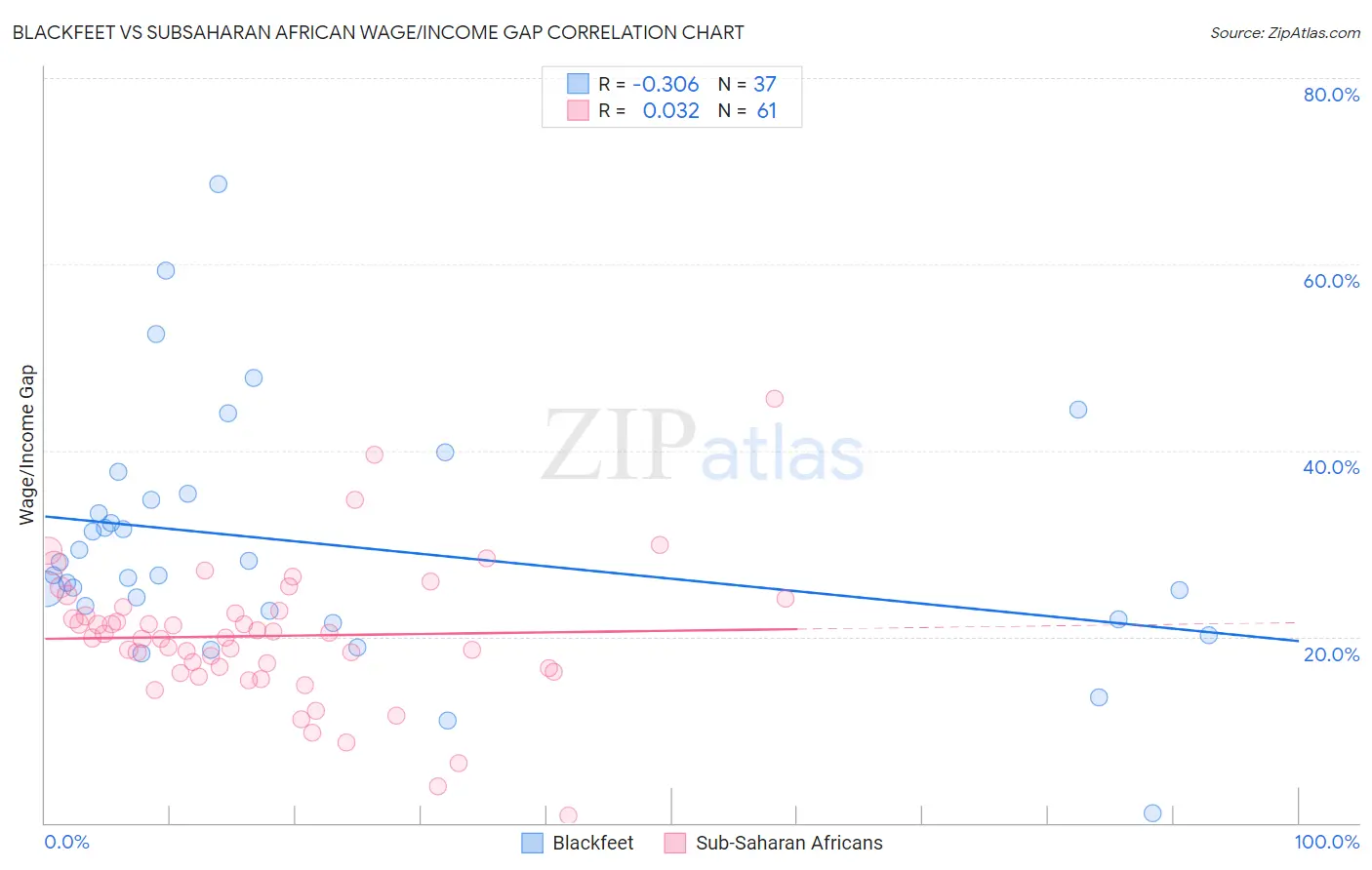Blackfeet vs Subsaharan African Wage/Income Gap
COMPARE
Blackfeet
Subsaharan African
Wage/Income Gap
Wage/Income Gap Comparison
Blackfeet
Sub-Saharan Africans
25.2%
WAGE/INCOME GAP
78.1/ 100
METRIC RATING
153rd/ 347
METRIC RANK
22.8%
WAGE/INCOME GAP
99.9/ 100
METRIC RATING
72nd/ 347
METRIC RANK
Blackfeet vs Subsaharan African Wage/Income Gap Correlation Chart
The statistical analysis conducted on geographies consisting of 309,305,291 people shows a mild negative correlation between the proportion of Blackfeet and wage/income gap percentage in the United States with a correlation coefficient (R) of -0.306 and weighted average of 25.2%. Similarly, the statistical analysis conducted on geographies consisting of 507,315,173 people shows no correlation between the proportion of Sub-Saharan Africans and wage/income gap percentage in the United States with a correlation coefficient (R) of 0.032 and weighted average of 22.8%, a difference of 10.6%.

Wage/Income Gap Correlation Summary
| Measurement | Blackfeet | Subsaharan African |
| Minimum | 1.1% | 0.79% |
| Maximum | 68.6% | 45.6% |
| Range | 67.5% | 44.8% |
| Mean | 29.9% | 20.1% |
| Median | 26.6% | 19.9% |
| Interquartile 25% (IQ1) | 22.3% | 16.4% |
| Interquartile 75% (IQ3) | 35.0% | 23.0% |
| Interquartile Range (IQR) | 12.7% | 6.6% |
| Standard Deviation (Sample) | 13.1% | 7.4% |
| Standard Deviation (Population) | 12.9% | 7.4% |
Similar Demographics by Wage/Income Gap
Demographics Similar to Blackfeet by Wage/Income Gap
In terms of wage/income gap, the demographic groups most similar to Blackfeet are Immigrants from Northern Africa (25.2%, a difference of 0.010%), Immigrants from Vietnam (25.2%, a difference of 0.040%), Immigrants from Mexico (25.3%, a difference of 0.16%), Costa Rican (25.3%, a difference of 0.22%), and Uruguayan (25.2%, a difference of 0.32%).
| Demographics | Rating | Rank | Wage/Income Gap |
| South Americans | 85.2 /100 | #146 | Excellent 25.0% |
| Malaysians | 84.9 /100 | #147 | Excellent 25.0% |
| Iroquois | 83.9 /100 | #148 | Excellent 25.1% |
| Immigrants | Peru | 82.6 /100 | #149 | Excellent 25.1% |
| Immigrants | Immigrants | 82.3 /100 | #150 | Excellent 25.1% |
| Taiwanese | 81.6 /100 | #151 | Excellent 25.1% |
| Uruguayans | 81.3 /100 | #152 | Excellent 25.2% |
| Blackfeet | 78.1 /100 | #153 | Good 25.2% |
| Immigrants | Northern Africa | 78.1 /100 | #154 | Good 25.2% |
| Immigrants | Vietnam | 77.7 /100 | #155 | Good 25.2% |
| Immigrants | Mexico | 76.4 /100 | #156 | Good 25.3% |
| Costa Ricans | 75.8 /100 | #157 | Good 25.3% |
| Immigrants | Zimbabwe | 73.7 /100 | #158 | Good 25.3% |
| Puget Sound Salish | 73.0 /100 | #159 | Good 25.3% |
| French American Indians | 72.5 /100 | #160 | Good 25.4% |
Demographics Similar to Sub-Saharan Africans by Wage/Income Gap
In terms of wage/income gap, the demographic groups most similar to Sub-Saharan Africans are Immigrants from Eastern Africa (22.8%, a difference of 0.030%), Immigrants from Burma/Myanmar (22.8%, a difference of 0.11%), Immigrants from El Salvador (22.8%, a difference of 0.15%), Immigrants from Uzbekistan (22.7%, a difference of 0.31%), and Fijian (22.9%, a difference of 0.39%).
| Demographics | Rating | Rank | Wage/Income Gap |
| Guatemalans | 99.9 /100 | #65 | Exceptional 22.6% |
| Central American Indians | 99.9 /100 | #66 | Exceptional 22.7% |
| Menominee | 99.9 /100 | #67 | Exceptional 22.7% |
| Immigrants | Nigeria | 99.9 /100 | #68 | Exceptional 22.7% |
| Indonesians | 99.9 /100 | #69 | Exceptional 22.7% |
| Immigrants | Uzbekistan | 99.9 /100 | #70 | Exceptional 22.7% |
| Immigrants | El Salvador | 99.9 /100 | #71 | Exceptional 22.8% |
| Sub-Saharan Africans | 99.9 /100 | #72 | Exceptional 22.8% |
| Immigrants | Eastern Africa | 99.9 /100 | #73 | Exceptional 22.8% |
| Immigrants | Burma/Myanmar | 99.9 /100 | #74 | Exceptional 22.8% |
| Fijians | 99.9 /100 | #75 | Exceptional 22.9% |
| Ecuadorians | 99.9 /100 | #76 | Exceptional 22.9% |
| Africans | 99.9 /100 | #77 | Exceptional 22.9% |
| Nigerians | 99.9 /100 | #78 | Exceptional 23.0% |
| Immigrants | Nicaragua | 99.9 /100 | #79 | Exceptional 23.0% |